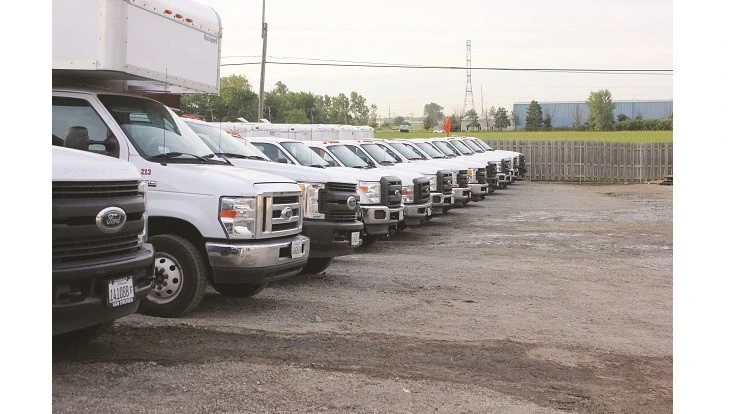

Seven years ago, Tim Groenewold’s property maintenance company was stuck at a million dollars in revenue. “I just couldn’t seem to make more profit,” says Groenewold, who owns C&T Lawn and Landscape, south of Chicago.
Then, Groenewold had an “a-ha moment” after observing a lawn care company of similar size execute a slick morning regimen. In contrast, it took crews nearly 45 minutes to leave C&T every morning, by the time they chatted, loaded, fueled and fixed their equipment. Groenewold realized that his company couldn’t move forward until he found a way to get crews out the door faster.
When he returned home from the conference, he started to streamline his team’s morning routine – trimming down prep time a few minutes every few months. Now, all 12 of C&T’s crews hit the road within five minutes after clocking in. Last year, they hit this departure goal 86 percent of the time.
Looking for ways to tighten your lawn care company’s morning routine? Try these nine tips to improve efficiency in your yard and get crews on the road faster.
1. Give crews their own space
One of the first changes Groenewold made to improve efficiency was moving to a larger facility five years ago – giving his 10 maintenance crews and two enhancement crews more room to move.
Similarly, Nate Moses takes advantage of the sprawling layout at the rented facility that Precision Landscape Management shares with two other businesses in Greenville, South Carolina. Precision’s central office is separated from equipment storage and parking areas. Moses, Precision’s president and founder, says “construction crews are in one area of our facility and maintenance is in a different area, so they’re not all over each other when they’re trying to load. That way, we don’t have to stagger start times or fight over space.”
2. Give crews dedicated tools
Groenewold also gave each crew its own enclosed trailer, stocked with its own dedicated equipment.
“We had open trailers, so we used to unload everything and put it in the shop at night,” he says. “A lot of times in the morning, I’d hear, ‘That’s my mower!’ But now, the guys have their own equipment so nobody (else) can touch it.”
Moses is also in the process of giving each division at Precision its own equipment. He’s also building up extra reserves to give each division its own backup tools, too. Another key, Moses adds, is repairing and replacing equipment regularly to reduce downtime and keep crews running. Speaking of which…
3. Hire a mechanic
In the past, Groenewold sent broken-down equipment offsite then waited three or four days for repairs. For smaller issues, handy crewmembers on staff helped with equipment maintenance – but they’d do it in the morning, which often held up crews.
Then, Groenewold hired a mechanic. “He works from noon to 8 every day, so when the crews get back at 3, 4, 5 in the afternoon, he’s there to make sure they’re ready for the next day,” he says. “It’s his responsibility to keep the crews running. It saved us a lot of money, because it was more expensive to send stuff off-site (and wait for repairs).”

4. Set an example of urgency
Moses doesn’t like to see managers sitting down before crews leave for the day; he expects them to walk around interacting with crews to make sure they’re ready to go. “It creates accountability, because if they see their managers walking around talking to them, that’s motivation to get out the door,” he says.
Groenewold, above, agrees that it’s important for him and his managers to be in the yard every morning to address any questions. The operations manager carries a clipboard, ready to track what time the last crew clears the yard. “You need to set an example from the top down,” Groenewold says. “You need to create the sense of urgency.”
Another way Groenewold visibly created urgency is by hanging a huge clock on the shop wall at C&T. “Everybody can see it from anywhere in the shop – and even halfway outside the shop,” he says, “so everyone knows it’s important.”
5. Bring fuel on-site
Four years ago, when Moses was still working in the field, he realized how much time his crew wasted at the gas station. “The time it took us to go in and get a snack would put us 15 to 30 minutes behind schedule,” he says.
That’s when he decided to get his own diesel and unleaded fuel delivered on-site, and it’s been well worth the investment. “Maybe I can pay lower prices at the pump,” he says, “but you can’t save enough pennies per gallon to make up for 30 to 60 minutes of downtime.”
6. Prep the night before
Even though Precision has gas on-site, crews are only allowed to fuel up at the end of the day. If they forget to top off their tank until morning, “they would be written up for that, and they would no longer be eligible for bonuses,” Moses says.
At both Precision and C&T, crews have checklists to complete every evening before they head home. For example, crew leaders pull up next to the fuel pump at C&T, then come inside to review the day with the operations manager. Meanwhile, the other guy or two on the crew start fueling, checking and loading equipment for the next day – discussing any necessary repairs with the on-site mechanic. Three days a week, the checklist includes an oil check, and once a week, crews return early to swap out blades for sharpening.
On average, C&T crews spend about 15 minutes at the end of the workday, prepping for the next day – which makes mornings go even faster.
“The only thing they need to do in the morning is go over any last-minute changes to their (schedule), double check the tires and then they’re out of here,” Groenewold says. “It just works so much better doing everything at night because all the crews aren’t here at once. It’s staggered, so there’s more room to move, and it’s safer, because there aren’t 24 guys running around at the same time.”
Be honest. Tim Groenewold shows employees a basic P&L to illustrate how wasted minutes matter.
7. Explain why efficiency matters
Groenewold started adjusting his team’s morning routine at the beginning of a new year, instead of trying to make drastic changes mid-season after crews fell into a groove. Even then, some employees were reluctant to change, so he had to clearly communicate what was in it for them.
“We sat down and explained why we were doing this. We explained, ‘If you can be more efficient, then that will raise your efficiency rating, which will directly affect your raises,’” Groenewold says. “They think you’re taking away this time that they get to talk to their friends on other crews, but you’re not. You’re actually giving them more, but you have to constantly remind them why it’s good for them and why it’s good for the company.”
Moses agrees that communication is critical to making changes to your crews’ routine.
“It’s important that you communicate upfront and give your team reasons why changes have to be made,” Moses says. “It’s one thing to say, ‘You guys are being lazy and taking too long,’ and it’s a totally different thing to say, ‘Hey guys, we’ve been looking at how we can be more efficient as a company and how we can make your lives easier. If we save money in these areas, we can afford more bonuses and buy newer equipment, so you have better tools and more time on-site.’ How you communicate these changes is very important.”

8. Track your numbers
Groenewold always tracked his team’s time so he knew roughly how much of their day was spent in the shop, in the truck, and actually working in the field. When he returned from the conference with a goal to speed up morning prep, this data gave him a measurable path to improve.
“Know your numbers,” Groenewold says. “Start tracking where you are now, even if it’s just for a week or a month. Then set a realistic goal and work toward it. You can’t improve what you don’t track.”
When Groenewold started this morning transformation, his crews left the yard about 40 minutes after clocking in. He set an initial goal of 15 minutes, and after they consistently met that goal, he shaved off five minutes at a time over the course of a year until they hit the five-minute mark.
9. Open your books
Tracking your numbers doesn’t do much good if you keep all the metrics to yourself. By sharing this data openly with your team, you help “explain the why” and spur crews into action.
“Everyone in my company sees the basic profit & loss on a monthly basis because it hangs in the office,” Groenewold says. “Even if they don’t understand all the numbers, they understand what I’m focused on and they understand how I expect them to improve that.”
This is a visual reminder of how you’re tracking toward your goal of a perfectly efficient morning.
“Guys are like, ‘Ah, a couple minutes here and there (won’t make a difference),’ but if you show them the numbers, it’s a big eye-opener that if everyone stands around for a couple minutes a day, at the end of the year, it costs the company a lot of money,” Groenewold says. “That’s why we’re doing this, because we can all (benefit) if we’re being more efficient.”

Explore the October 2019 Issue
Check out more from this issue and find your next story to read.
Latest from Lawn & Landscape
- Bartlett Tree Experts gave away 50,000 tree seedlings for Arbor Day
- Connect, Control & Conserve with Horizon Technical Services
- Use Horizon's Parts Hotline
- How I built a Top 100 company
- Horizon’s Exclusive TurfGro Fertilizer
- Grow your business with mosquito control
- LandCare adds 2 branches in SoCal, promotes Aleman to branch manager
- Spray them away





